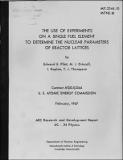| dc.contributor.author | Pilat, E. E., 1937- | en_US |
| dc.contributor.author | Driscoll, Michael J. | en_US |
| dc.contributor.author | Kaplan, Irving, 1912- | en_US |
| dc.contributor.author | Thompson, Theos Jardin, 1918-1970 | en_US |
| dc.contributor.other | Massachusetts Institute of Technology. Department of Nuclear Engineering | en_US |
| dc.contributor.other | U.S. Atomic Energy Commission | en_US |
| dc.date.accessioned | 2014-09-16T23:29:43Z | |
| dc.date.available | 2014-09-16T23:29:43Z | |
| dc.date.issued | 1967 | en_US |
| dc.identifier.uri | http://hdl.handle.net/1721.1/89689 | |
| dc.description | Statement of responsibility on title page reads: Edward E. Pilat, M.J. Driscoll, I. Kaplan, and T.J. Thompson | en_US |
| dc.description | "February 1967." | en_US |
| dc.description | Includes errata | en_US |
| dc.description | "MIT-2344 -10" | en_US |
| dc.description | Also issued as a Ph. D. thesis by the first author (Pilat) and supervised by the last author (Thompson), Massachusetts Institute of Technology, Dept. of Nuclear Engineering, 1967 | en_US |
| dc.description | Includes bibliographical references | en_US |
| dc.description.abstract | The nuclear parameters of a reactor lattice may be determined by critical experiments on that lattice, by theoretical calculations in which only cross sections are used as input, or by methods which combine theory and experiment. Of those methods which combine theory and experiment, the Single Element Method, abbreviated SEM, is shown to have great usefulness. As used here, the method combines experiments on the smallest meaningful unit of fuel - a single fuel element - with a theory which relates the behavior of a lattice of such elements to the experimentally determined behavior of the single element. This particular division of the problem into theory and experiment is useful for at least three reasons. | en_US |
| dc.description.abstract | First, several parameters which characterize a reactor lattice - the thermal utilization and resonance escape probability, for example - often depend strongly and in a complicated manner on the properties of individual fuel elements, but only depend weakly or in a simple manner on interactions between the fuel elements. In the Single Element Method, the largest contribution to these parameters is determined by measurements on a single fuel element, and only a relatively small correction to account for the presence of the rest of the fuel elements need be estimated theoretically. Second, the determination of lattice parameters in this way represents a desirable saving of time, money, effort, and material over their determination in critical or exponential experiments. | en_US |
| dc.description.abstract | Third, it is shown that the method provides an excellent way of correlating the results of experimental measurements, since it shows what pertinent variables must be used to express the quantity of interest in a linear or nearly linear fashion. Values obtained by the SEM for the thermal utilization of lattices of uranium rods in heavy water are accurate to about 0.3 percent (by comparison with THERMOS). Values of P28, 28, and C* are obtained by the SEM for the same lattices to an accuracy of between five and ten percent (by comparison with experiment). The same method yields values of 28 with are equally accurate in lattices moderated by light water. In addition, the theoretical development of the SEM predicts that P28, 28, C*, and 625 should vary nearly linearly with the inverse of the unit cell volume (for a fixed size of fuel element). This explains the experimentally observed behavior and provides an important tool for the rational correlation of experimental results. | en_US |
| dc.description.sponsorship | U.S. Atomic Energy Commission contract AT (30-1)2344 | en_US |
| dc.format.extent | 182 pages | en_US |
| dc.publisher | Cambridge, Mass. : Massachusetts Institute of Technology, Dept. of Nuclear Engineering, [1967] | en_US |
| dc.relation.ispartofseries | MIT-2344 -10 | en_US |
| dc.relation.ispartofseries | MITNE ; no. 81 | en_US |
| dc.relation.ispartofseries | AEC research and development report | en_US |
| dc.subject.lcc | TK9008.M41 N96 no.81 | en_US |
| dc.subject.lcsh | Nuclear fuel elements | en_US |
| dc.title | The Use of experiments on a single fuel element to determine the nuclear parameters of reactor lattices | en_US |
| dc.type | Technical Report | en_US |
| dc.identifier.oclc | 856013349 | en_US |
